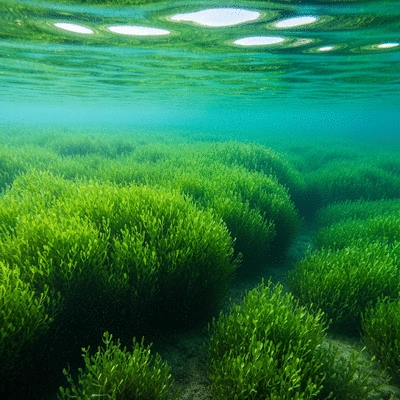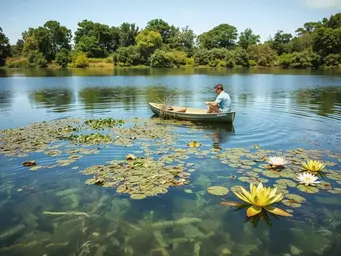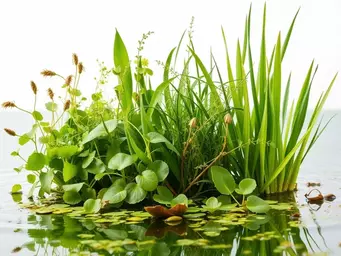Dense Mat Formation
Forms extensive surface coverage, blocking sunlight, trapping debris, and creating stagnant areas.
- Hinders recreational activities.
- Increases harmful microorganism growth.

As we navigate the intricate web of aquatic ecosystems, it's vital to understand the pivotal role that invasive species like Brazilian Waterweed play in disrupting these environments. With its rapid growth and overwhelming presence, Egeria densa is more than just a plant; it’s a significant threat to biodiversity and water quality. This understanding equips us with the knowledge needed to combat its adverse effects and restore balance to our waterways.
Brazilian Waterweed (Egeria densa) significantly alters aquatic environments. The following visual summarizes its key disruptive impacts across various ecological aspects.
Brazilian Waterweed, or Egeria densa, poses significant challenges to our aquatic ecosystems. As an ecologist and founder of Aquatic Weed Solutions, I've seen firsthand how this invasive species disrupts the delicate balance of waterways. Understanding the ecological effects of Brazilian Waterweed is crucial for effective management and restoration efforts.
In this section, we will explore how Brazilian Waterweed affects aquatic systems, from its dense growth patterns to its impact on native biodiversity. Let's dive in!
When Brazilian Waterweed establishes itself in a waterway, it can form dense mats that alter the environment dramatically. These mats block sunlight from reaching other plants and aquatic life, creating a ripple effect throughout the ecosystem. Moreover, they can lead to reduced water flow in rivers and lakes, compounding the issue.
The formation of these mats ultimately disrupts the natural aquatic habitat, making it essential to recognize and manage this invasive species effectively.
As Egeria densa proliferates, it can create extensive surface coverage, which leads to several environmental consequences. These mats not only obstruct sunlight but can also trap debris, resulting in a buildup of organic matter beneath the surface. This accumulation can further degrade water quality and fuel the growth of harmful microorganisms. The U.S. Geological Survey (USGS) provides detailed fact sheets on invasive aquatic plants like Egeria densa, highlighting their potential to alter ecosystems significantly.

Identifying these mats early on is key. Regular monitoring can help landowners and waterway managers take action before the issue escalates.
Dense growths of Brazilian Waterweed can significantly alter the oxygen levels in the water. As the plant decays, it consumes oxygen, which can lead to hypoxic conditions, creating an unlivable environment for many aquatic species. Additionally, the sedimentation rates can increase due to the organic material trapped by the mats, leading to further disruptions in the aquatic ecosystem.
By understanding these impacts, we can better assess the health of our waterways and recognize the need for management strategies that promote ecological balance.
Eutrophication, a process driven by nutrient overload, plays a significant role in the challenges posed by Brazilian Waterweed. When nutrients like nitrogen and phosphorus enter the water, they fuel the growth of not only Brazilian Waterweed but also algae, leading to harmful algal blooms. These blooms further degrade water quality, producing toxins and reducing oxygen levels.
By addressing the causes of eutrophication, we can create a proactive approach to managing Brazilian Waterweed and its impacts on water quality.
Biodiversity is essential for healthy aquatic ecosystems, yet Brazilian Waterweed poses a significant threat to it. When it takes over, it can crowd out native plants, disrupting the intricate balance that supports various aquatic life forms. These invasive plants compete for resources such as light, nutrients, and space. Research by IGB Berlin highlights the high economic damage caused by invasive aquatic plants worldwide, underscoring their ecological impact.
Understanding how this competition affects native species is crucial for our conservation efforts. As I've seen in my work, fostering native biodiversity can help restore ecological balance.
Brazilian Waterweed's rapid growth can quickly outcompete native vegetation, which is vital for habitat stability. This competition can lead to a decline in native plant species, which play essential roles in supporting fish populations and providing shelter for various aquatic organisms.

Restoring native plants can act as a natural defense against invasives, highlighting the need for informed management practices.
The consequences of Brazilian Waterweed extend to fish populations as well. As native plants diminish, fish species may decline due to the loss of habitat and food sources. This disruption can lead to a cascading effect throughout the aquatic food web, impacting not only fish but also the entire ecosystem.
By actively managing Brazilian Waterweed, we aim to protect the health of fish populations and the integrity of our aquatic food webs.
Finally, the presence of Brazilian Waterweed can lead to significant habitat loss for various species that rely on diverse aquatic environments. The homogenization of habitats due to dense growth can eliminate niche areas vital for many organisms, leading to declines in both species richness and abundance. A study on biological invasions in rivers and lakes further illustrates these pervasive impacts.
As I continue my work with Aquatic Weed Solutions, it's clear that understanding and addressing these impacts is crucial for the preservation of our aquatic ecosystems. Together, we can work toward healthier waterways!
Have you encountered Brazilian Waterweed in your local waterways? Share your experiences and thoughts on how it has impacted your community:
As we contemplate the future of waterway management, it’s essential to focus on long-term ecological recovery after the removal of invasive species like Brazilian Waterweed. Implementing effective strategies can lead to a more balanced aquatic ecosystem, allowing native species to thrive once again.
Restoration efforts can be multifaceted, addressing not only the immediate removal of invasive species but also enhancing the overall health of the waterway. Here are some key strategies that can support the restoration of aquatic habitats:
By monitoring these aspects closely, we can not only aid in the recovery of aquatic habitats but also enhance the resilience of our ecosystems against future invasions. As an ecologist, I’ve seen firsthand how these strategies can lead to revitalized waterways, rich in biodiversity.
Monitoring and supporting the recovery of native species is crucial after invasive species removal. Tracking the progress of native plant regrowth and assessing the conditions of the waterway can provide valuable insights.
With strong monitoring programs in place, we can identify areas needing additional support and implement new strategies to protect and restore our aquatic ecosystems. In my experience, fostering these relationships not only enhances ecological understanding but also builds community ties!
The landscape of invasive species management is constantly evolving, thanks to emerging technologies that offer innovative solutions for controlling and monitoring invasive species. These advancements can significantly enhance our ability to manage Brazilian Waterweed effectively.
By staying informed about these technological advancements, we can leverage them to create more effective management practices. At Aquatic Weed Solutions, we’re committed to exploring these opportunities while sharing our findings with the community, helping to ensure a healthier future for our waterways.
Community involvement is vital in the quest for sustainable waterway management. Successful case studies have shown that when local residents come together to protect their waterways, the impact can be profound.
Communities that have successfully engaged in waterway conservation often share a few common characteristics. Here are some initiatives that have made a significant difference:
These efforts have demonstrated that collective action can lead to tangible improvements in waterway health. As an environmental educator, I’ve seen how communities can come alive with purpose when they feel a connection to their natural surroundings!
Every individual has a role to play in waterway conservation, and there are many simple yet effective actions that can be taken. Here’s how you can contribute:
When we all take small steps, it can lead to significant progress in protecting our waterways. Every effort counts, and together, we can make a lasting impact!
Raising awareness about invasive species is essential for fostering a culture of conservation. Effective public awareness campaigns can significantly educate communities and encourage proactive management approaches.
At Aquatic Weed Solutions, we believe that education is the cornerstone of effective management. By equipping communities with knowledge, we empower them to take action and safeguard their aquatic environments for future generations!
Here is a quick recap of the important points discussed in the article:
Managing Aquatic Weeds Effectively

As we delve into the hidden challenges of our water ecosystems, understanding the role of aquatic we
Impact of Aquatic Weeds on Recreation

As we dive into the world of aquatic ecosystems, the presence of invasive aquatic weeds may not only
Understanding Aquatic Weed Varieties

What if understanding aquatic weeds could be the key to restoring our waterways? As we dive deeper i
Managing Aquatic Weeds Effectively
Impact of Aquatic Weeds on Recreation
Understanding Aquatic Weed Varieties
Integrated Aquatic Weed Management Methods
Integrated Approaches to Aquatic Weeds